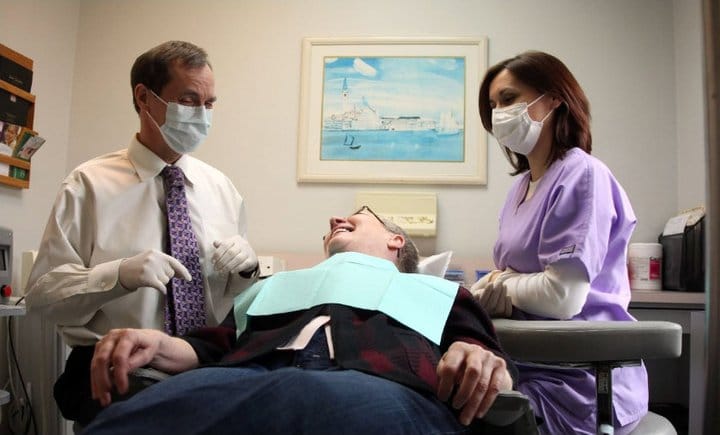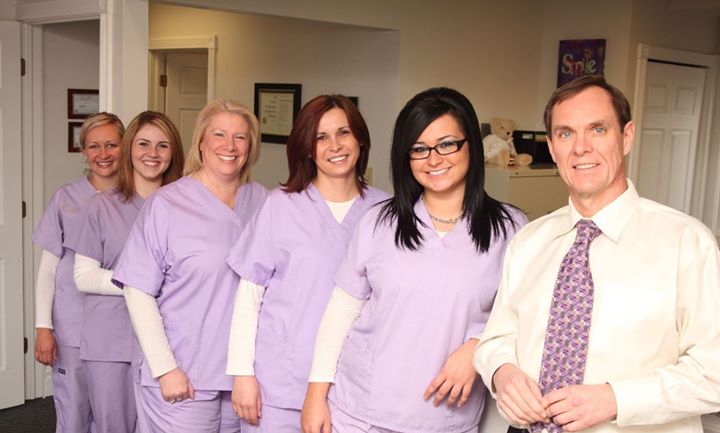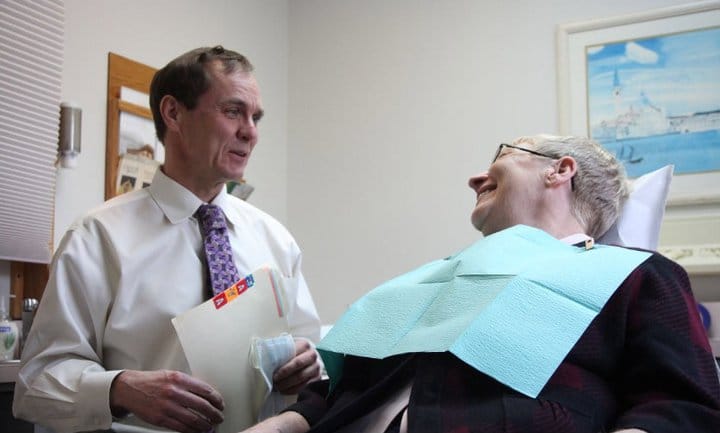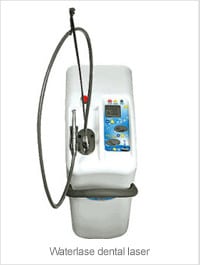Checkout Dr. Thomas Gibbs, DDS, FAGD, FDOCS, FICOI Watch Video
Dr. Gibbs grew up in nearby Elmhurst where his father was the local orthodontist. He has been married to his wife Catherine, a Glen Ellyn native, for over 30 years now. Dr. Gibbs established his Glen Office in 1978, after first working in downtown Chicago, so they could raise their children in Glen Ellyn. They have two daughters—Jessica and Christine. His daughter Jessica proudly has become the fourth generation dentist, recently following his footsteps by graduating the University of Illinois. They enjoy skiing, water sports, tennis, and long walks.
Dr. Gibbs has over 25 years of experience in cosmetic, family sedation, and implant dentistry. He is one of the earliest members of the American Academy of Cosmetic Dentistry (since 1998), and has had training at some of the most prestigious training institutes such as the L.D. Pankey Institute for Advanced Education, California Implant Institute, Misch International Implant Institute, and the Las Vegas Institute for Advanced Dental Studies (LVI).
Cosmetic Dental Implants
Dental implants are not only safer for the adjacent teeth (not partial clasps or unnecessary tooth reduction for tooth bridges), but a tooth implant are usually more esthetic. When dental implant surgery is properly done the gums that “support the smile” can be maintained. Also the bone loss that occurs under tooth-supported bridges does not occur trapping food and odors.
The material we use not for dental implant crowns and bridges are also more cosmetic using no metal showing as with other tooth replacement options. Cosmetic dental implants and tooth replacements are often combined with other cosmetic dental procedures such as porcelain crowns and porcelain veneers as in the example below where the back teeth were replaced with implant bridges, and the front teeth with veneers.
How Long Will An Implant Last?
In some individual cases, modern dental implants have been maintained in good condition for greater than forty years. Continued care is still need for an implant after placement, even though it is made out of metal. This includes both patient home care and professional maintenance. The useful life of a dental implant varies according to the factors of patient health, patient habits such as oral hygiene and smoking, and structural overload.
Dental implants are not subject to ordinary tooth decay, fashioned as they are out of titanium, but the crowns and dental bridges they support are still worn down by use. Patients need to be aware that they need to maintain the health of the gums around the implants. With proper dental care, implants can be expected to last for the full lifetime of the patient!
What are Dental Implants Used For?
The dental implant is simply the supporting fixture for subsequent dental restorations. Common “end-uses” are:
- Replacing a single missing tooth – This is of course the most common use. See our section on Dental Implant Crowns
- Replacing a tooth supported bridge — The primary problem with a tooth supported bridge is that if any part fails the entire bridge fails. Also the supporting teeth are more frail and prone to failure. See section on dental implant bridges.
- Replacing partial dentures – Many people “hate their partials” as they can damage the supporting teeth and often get food caught beneath them. See our section on Replacing Partial Dentures.
- Loose Dentures — These dentures can be “locked down” into place. They are still removable, but more comfortable. See section on implant supported dentures.
- Eliminate dentures — Many people “hate their dentures” and all the plastic in their mouths. Dental implants can be used to eliminate dentures altogether and have fixed not removable dental bridges. See our section on Dental implant bridges and “All on Four” or “Teeth in a Day.”
Bone Grafting for Dental Implants
Many people wonder what treatments and procedures are used in cosmetic dentistry, and what their potential and limitations are. Some of the most popular methods performed today are oral bone implants, various types of titanium dental implants, and cosmetic dentistry bonding. Bone grafts (osseous augmentation) are a frequent choice by people who want to restore chewing function, and to improve their appearance, after suffering dental damage from periodontal disease or injury. Without adequate amounts of bone, many cosmetic or dental implant procedures would be impossible, making the graft the crucial first step in many restorative actions.
Types of Bone Grafts
Depending on the patient, different types of bone grafts are used. Some of the most common materials for bone grafting include:
- Autogenous bone
- Allografts
- Xenografts
- Barrier membranes
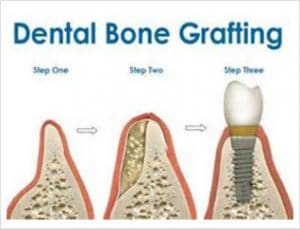 Though every one of these materials is excellent at restoring bone quantity and quality safely, quickly, and effectively, autogenous bone grafts are superior to the rest. They are produced from bones in the individual’s own body, which helps prevent rejection of the bone material by the body’simmune defenses. Autogenous bone is frequently taken from areas such as the chin, the jawbone, or the hip.
Though every one of these materials is excellent at restoring bone quantity and quality safely, quickly, and effectively, autogenous bone grafts are superior to the rest. They are produced from bones in the individual’s own body, which helps prevent rejection of the bone material by the body’simmune defenses. Autogenous bone is frequently taken from areas such as the chin, the jawbone, or the hip.
Allografts are carried out using bone from other individuals, sometimes cadavers. Xenografts are transplants between species, in this case using pig or cow bone transplanted into the human mouth. For bone grafting procedures, we use autogenous bone (the bone of the individual patient themselves) whenever possible.
Implant Supported Bridges to Eliminate Dentures
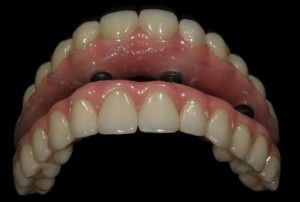 Implant supported bridges are the ultimate replacement for dentures. They are fashioned in much the same way as regular bridges, but utilize implants as their supports rather than ground-down regular teeth like the ordinary type uses. Several of the advantages of this method of fixing your oral problems include the fact that pressure from chewing is distributed between all the implants supporting the dental bridges, rather than being concentrated on just one at a time. This makes the arrangement extremely tough and durable. The bridge itself is made out of high quality porcelain, fused onto a metal support, and is visually indistinguishable from natural teeth most of the time. The bridge is cleaned like ordinary teeth, though you should also floss between the fixture and the gum in order to maintain proper hygiene and gum health.
Implant supported bridges are the ultimate replacement for dentures. They are fashioned in much the same way as regular bridges, but utilize implants as their supports rather than ground-down regular teeth like the ordinary type uses. Several of the advantages of this method of fixing your oral problems include the fact that pressure from chewing is distributed between all the implants supporting the dental bridges, rather than being concentrated on just one at a time. This makes the arrangement extremely tough and durable. The bridge itself is made out of high quality porcelain, fused onto a metal support, and is visually indistinguishable from natural teeth most of the time. The bridge is cleaned like ordinary teeth, though you should also floss between the fixture and the gum in order to maintain proper hygiene and gum health.
Some of the benefits you can expect from this oral treatment include:
- May be an upgrade from implant retained or support overdentures.
- Lets you eat and function as though you still had your natural teeth
- A solid, stable solution compared to dentures.
- Preserves your facial appearance and prevents bone loss.
- Immediate function in mandible and maxilla.
- Gives a nice, natural smile with better esthetics than dentures offer.
Invisalign Invisible Braces
Straight, even teeth give your mouth a stylish and attractive look, but might seem like they could be achieved only through the use of painful metal braces, with all the problems that they entail. Furthermore, while kids are expected to have braces, an adult smiling with a mouthful of steel wires is another matter entirely – presenting an esthetically unpleasant picture that would fit in poorly with a social situation, a business meeting, or a romantic moment.
Fortunately, the advance of technology has provided an exciting solution in the form of Invisalign braces. These tooth straightening aids were made possible by today’s precision computer manufacturing and modern medical dental materials. They gradually shift your teeth to the desired position over the course of several months, while remaining mostly invisible.
Conscious Sedation Dentistry
Oral sedation is one of the newest methods of anxiety control in dentistry. Sedatives delivered in pill form produce a very relaxed state in most patients. Recent pharmacological developments have given dentistry oral drugs which produce deep relaxation while remaining very safe. This was impossible as recently as ten years ago. Many United States dentists practice oral sedation today, though with widely varying levels of expertise.
The first tablet is taken an hour before your scheduled appointment, and the second is given in the office an hour before the actual treatment starts. Sometimes several pills are given, depending on circumstances. If you are comfortable at this point, additional doses may or may not be given, depending both on your doctor’s training and the state where you are being treated.
This dental sedation technique is very well received among many patients, and is quite effective for short appointments. Oral sedatives are beneficial in several ways, including the fact that they reduce pain more effectively than other sedations and that they eliminate memories of dental procedures in most patients.
Some patients who benefit most from oral sedatives include:
- Patients whose anxiety is higher than average, and who thus need shorter appointments.
- “Special needs” and handicapped patients who want more done during each dental visit.
- Patients who want a lot of work done during each appointment, and/or those who want more comfort.
- People whose mouths are difficult to numb and who therefore need their nervous system to be “toned down.”
- People susceptible to gagging.
- As a prelude to Dental IV sedation for patients with severe needle phobia.
Advanced Laser Dentistry
Laser Dentistry for Gum Surgery, Detecting Decay, and Fillings
Laser dentistry is a fairly new addition to the oral health field, but has proven itself safe and effective for a number of different procedures. Though not a panacea, laser dentistry opens up many possibilities for leading edge treatments that lack some of the main downsides of older methods, while providing the same benefits, or even superior performance in certain cases. Some of the methods that we use are described in more detail below.
The Waterlase Dental Laser for Dental Fillings
Laser-energized water, or hydrokinetics, gently washes away tooth decay with incredible accuracy. The waterlase dental laser can replace the drill for most dental procedures and treatments. The Waterlase Dentist Laser used by Dr. Gibbs does away with the annoying whine of the drill and the smell of drilled enamel. Because Dr. Gibbs uses a laser, there is no frictional heat or vibration, reducing the dependence on needles and anesthesia.
Some of the advantages of using this system include:
- The exactness possible with the Waterlase means that less tissue and healthy tooth material is removed, leaving sound structures in place and thus damaging your mouth as little as possible in the process of curing certain problems.
- Due to lack of swelling, bleeding, painkillers, and so on, it is safe to carry out multiple procedures in one dentist’s visit, thus saving time, money, and frustration.
- The absence of bleeding holes in your mouth or numbed cheeks, lips, or tongue from anesthetics, or dental sedation options means that the period immediately after treatment is far more pleasant than otherwise.
- The lack of open wounds greatly reduces the risk of post-surgical infection. Swelling and discomfort are minimized, which is a benefit in practically anyone’s view.
r



